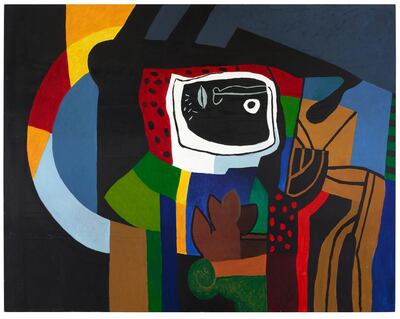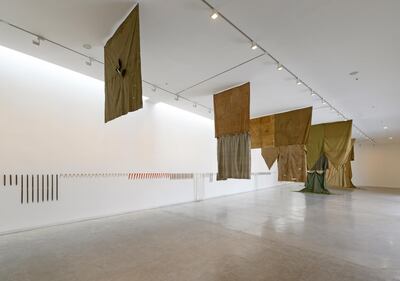March has come around again. Many around the world will remember it as a time when the Covid-19 pandemic took hold and affected millions in a number of ways. For the local art scene, March is also the start of a new season of exhibitions and programmes, most of which were postponed or cancelled in 2020.
This year, the art scene hopes to bounce back with the return of Art Dubai in its physical form (last year’s went virtual), the opening of new spaces, including Foundry in Downtown Dubai, major shows at Sharjah Art Foundation, which just wrapped up its March Meeting, and a series of events at Alserkal Avenue as part of Galleries Night and Art Week.
Art Dubai
Due to the pandemic, Art Dubai has scaled down its 2021 iteration and moved venues from Madinat Jumeirah to the outdoor plaza under the Dubai International Financial Centre's (DIFC) Gate Building. Fair dates have also been extended from three days to six, and booths will be housed in purpose-built structures outdoors for better ventilation.
A total of 50 galleries from the region and beyond are participating in the event. This year, Art Dubai will introduce “remote booths”, which allow galleries from outside the UAE to put up works while the fair’s trained staff deal with collectors on the ground.
Art Dubai will not announce the Ithra Art Prize winner for this year, but will show the work of Fahad bin Naif, who won last year. A section of the fair will also be dedicated to showcasing video works by various artists, and Campus Art Dubai returns with the exhibition that was initially slated for 2020.
From Monday, March 29, to Saturday, April 3; Gate Building, DIFC, Dubai; artdubai.ae
Galleries Night at Alserkal Avenue
Alserkal Avenue’s Art Week begins with Galleries Night on Monday, with galleries presenting new shows and guest projects opening across the arts cluster in Al Quoz.
The Sacred Space Oddity
Premiering at BredaPhoto last year, the Sacred Space Oddity by Tanya Habjouqa features the award-winning photographer's quirky and layered series Occupied Pleasures on everyday life in Israel and Palestine, particularly the West Bank, Jerusalem and Gaza.
Habjouqa employs surrealist elements in her imagery as a way to “challenge the simplifying mythologies that emerge in regions of conflict, both about ‘the other side’ and which populations tell themselves about who they are and who they seek to be". Her photos capture characters that the photographer describes as “co-authors” of the project – a priest posing next to superhero mannequins, for example, or women practising yoga in the outskirts of Bethlehem.
From March 22 to May 30; Gulf Photo Plus, Dubai; gulfphotoplus.com
Hortus Arcanus
In this solo exhibition by Simrin Mehra Agarwal, the artist presents large-scale drawings of overlapping organic forms that appear as tentacles, coral, kelp and various forms of plant life.
Through the work, the artist produces her own hybrids as she examines ideas of growth and decay in nature. She also references the landscape of her childhood in West Bengal, specifically the heavily forested district of Jhargram. This link to nature is also mentioned in the show’s title, Hortus Arcanus, which translates to "secret garden" in Latin.
From March 22 to April 30; 1x1 Art Gallery, Dubai; 1x1artgallery.com
The Work and its Periphery
Lebanese artist Charbel-joseph H Boutros unveils a new project at Grey Noise that looks at the recent reshaping of the art world in the midst of the Covid-19 pandemic. The artist, who lives between Beirut and Paris, is known for poetic works, often sculpture and installation, that reflect on political histories.
For his latest installation, however, H Boutros turns towards issues such as exhibition-making and what the gallery describes as “the fragile role of the gallerist’s personage trying constantly to channel an algorithmic art market empire”. The show won’t be the first time that the gallery has critiqued art-making and the art world, though this latest project by H Boutros frames these issues within our unique, current circumstances.
From March 22 to May 22; Grey Noise, Dubai; greynoise.org
The Lebanon Works
A pioneering figure in modern Arab art, Iraqi painter Dia Azzawi is known for incorporating Arabic calligraphy and symbols from Iraqi history into his works. His latest paintings, which are the focus of Meem Gallery’s upcoming show, bring in new elements drawn from the coastal town of Chekka in Lebanon, where Azzawi has recently opened a studio.
Produced in 2019, the three large-scale works feature Azzawi’s bold use of colour, rendering elements of land and sky, and explore themes of exile and loss through symbolic human figures referencing Sumerian visual art.
From March 23 to June 24; Meem Gallery, Dubai; meemgallery.com
Kn-bkhair
In this solo exhibition, Emirati artist Hamdan Buti Al Shamsi explores the self – from the conscious and subconscious sides to the concept of the soul – through a body of work developed over the past year.
The show is a culmination of the artist’s research at Tashkeel’s Critical Practice Programme 2020, where he was mentored by artist and curator Hind bin Demaithan Al Qemzi. Al Shami’s first solo exhibition includes prints, video, installation and handwritten poetry that takes viewers on a journey into the artist’s world, but also raises questions about identity.
Until April 24; Tashkeel Studio and Gallery, Dubai; tashkeel.org
Line as a Universe: Between the Past and the Future
The newly established art space Foundry in Downtown Dubai is showcasing four new exhibitions, including a solo presentation by Russian-Kazakh artist Adil Aubekerov. Organised by curator Dina Baitassova, the show features Aubekerov’s expressive and complex paintings that fuse petroglyphs with symbols from Kazakhstan’s visual culture. His visuals are an amalgam of styles, from cave painting figures to modern graffiti and graphic design elements.
In his works, the artist intertwines creatures and characters through seemingly unbroken lines, resulting in intricate compositions that unravel new elements with each view. He produces the works in a “free flow of consciousness”, drawing from his imagination as he goes.
Until April 17; Foundry, Dubai; downtowndubai.ae
Rayyane Tabet: Exquisite Corpse
Rayanne Tabet's latest exhibition at Sharjah Art Foundation includes works from his ongoing Fragments project, as well as newly commissioned works, including a digital archive of historical records that is open to the public.
Since 2016, Tabet has been expanding Fragments, a project that uses Baron Max von Oppenheim's archaeological excavation at Tell Halaf in north-east Syria as its starting point. Years ago, Tabet discovered that his great-grandfather Faek Borkhoche worked as the historian and archaeologist's translator for six months. The artist's work digs into this personal history, weaving it with larger stories in the region.
Until June 15; Al Mureijah Square, Sharjah Art Foundation; sharjahart.org
Lasting Impressions: Baya Mahieddine
The latest major retrospective at Sharjah Art Museum puts a spotlight on Baya, the self-taught Algerian artist and modern art figure that found herself launched into artistic renown at the age of 16.
The exhibition, part of the museum’s Lasting Impression series, which highlights established Arab artists throughout the ages, includes more than 70 artworks by Baya, with loans from private collectors and institutions around the world.
Curators Alya Al Mulla and Suheyla Takesh present unique research, including an interview between the artist and Salwa Mikdadi, an academic and curator who showcased her work previously.
Until July 31; Sharjah Art Museum, Sharjah; sharjahartmuseum.ae
Abstraction and Calligraphy – Towards a Universal Language
Louvre Abu Dhabi’s latest exhibition examines how artists in the early 20th century sought to establish a universal visual vocabulary and traces the influences of Asian and Islamic calligraphy in their works. Hieroglyphics, Kufic script and Zen calligraphy were among the writing systems that artists such as Paul Klee, Joan Miro and Andre Masson, and Wassily Kandinsky studied and dissected to create paintings that exemplify the shift towards abstraction in western art history.
The exhibition comprises four sections and includes two new commissions by eL Seed and Sanki King.
Until June 12; Louvre Abu Dhabi, Abu Dhabi; louvreabudhabi.ae








